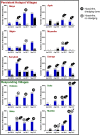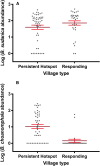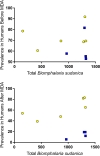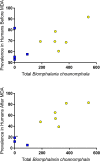A Search for Snail-Related Answers to Explain Differences in Response of Schistosoma mansoni to Praziquantel Treatment among Responding and Persistent Hotspot Villages along the Kenyan Shore of Lake Victoria
- PMID: 31162012
- PMCID: PMC6609173
- DOI: 10.4269/ajtmh.19-0089
A Search for Snail-Related Answers to Explain Differences in Response of Schistosoma mansoni to Praziquantel Treatment among Responding and Persistent Hotspot Villages along the Kenyan Shore of Lake Victoria
Abstract
Following a 4-year annual praziquantel (PZQ) treatment campaign, the resulting prevalence of Schistosoma mansoni was seen to differ among individual villages along the Kenyan shore of Lake Victoria. We have investigated possible inherent differences in snail-related aspects of transmission among such 10 villages, including six persistent hotspot (PHS) villages (≤ 30% reduction in prevalence following repeated treatments) located along the west-facing shore of the lake and four PZQ-responding (RESP) villages (> 30% prevalence reduction following repeated treatment) along the Winam Gulf. When taking into account all sampling sites, times, and water hyacinth presence/absence, shoreline-associated Biomphalaria sudanica from PHS and RESP villages did not differ in relative abundance or prevalence of S. mansoni infection. Water hyacinth intrusions were associated with increased B. sudanica abundance. The deeper water snail Biomphalaria choanomphala was significantly more abundant in the PHS villages, and prevalence of S. mansoni among villages both before and after control was positively correlated with B. choanomphala abundance. Worm recoveries from sentinel mice did not differ between PHS and RESP villages, and abundance of non-schistosome trematode species was not associated with S. mansoni abundance. Biomphalaria choanomphala provides an alternative, deepwater mode of transmission that may favor greater persistence of S. mansoni in PHS villages. As we found evidence for ongoing S. mansoni transmission in all 10 villages, we conclude that conditions conducive for transmission and reinfection occur ubiquitously. This argues for an integrated, basin-wide plan for schistosomiasis control to counteract rapid reinfections facilitated by large snail populations and movements of infected people around the lake.
Figures







Similar articles
-
Comparative Vectorial Competence of Biomphalaria sudanica and Biomphalaria choanomphala, Snail Hosts of Schistosoma mansoni, From Transmission Hotspots In Lake Victoria, Western Kenya.J Parasitol. 2021 Mar 1;107(2):349-357. doi: 10.1645/20-138. J Parasitol. 2021. PMID: 33906231 Free PMC article.
-
Longitudinal survey on the distribution of Biomphalaria sudanica and B. choanomophala in Mwanza region, on the shores of Lake Victoria, Tanzania: implications for schistosomiasis transmission and control.Parasit Vectors. 2017 Jun 28;10(1):316. doi: 10.1186/s13071-017-2252-z. Parasit Vectors. 2017. PMID: 28659165 Free PMC article.
-
Molecular xenomonitoring of Schistosoma mansoni infections in Biomphalaria choanomphala at Lake Victoria, East Africa: Assessing roles of abiotic and biotic factors.PLoS Negl Trop Dis. 2025 Jan 2;19(1):e0012771. doi: 10.1371/journal.pntd.0012771. eCollection 2025 Jan. PLoS Negl Trop Dis. 2025. PMID: 39746048 Free PMC article.
-
Important aspects of Biomphalaria snail-schistosome interactions as targets for antischistosome drug.Med Sci Monit. 2006 Dec;12(12):RA282-292. Epub 2006 Nov 23. Med Sci Monit. 2006. PMID: 17136018 Review.
-
Resistance of Schistosoma mansoni to praziquantel: is there a problem?Trans R Soc Trop Med Hyg. 2002 Sep-Oct;96(5):465-9. doi: 10.1016/s0035-9203(02)90405-0. Trans R Soc Trop Med Hyg. 2002. PMID: 12474468 Review.
Cited by
-
Species diversity and distribution of schistosome intermediate snail hosts in The Gambia.PLoS Negl Trop Dis. 2021 Oct 4;15(10):e0009823. doi: 10.1371/journal.pntd.0009823. eCollection 2021 Oct. PLoS Negl Trop Dis. 2021. PMID: 34606509 Free PMC article.
-
The genome and transcriptome of the snail Biomphalaria sudanica s.l.: Immune gene diversification and highly polymorphic genomic regions in an important African vector of Schistosoma mansoni.bioRxiv [Preprint]. 2023 Nov 2:2023.11.01.565203. doi: 10.1101/2023.11.01.565203. bioRxiv. 2023. Update in: BMC Genomics. 2024 Feb 19;25(1):192. doi: 10.1186/s12864-024-10103-w. PMID: 37961413 Free PMC article. Updated. Preprint.
-
Discovering, Defining, and Summarizing Persistent Hotspots in SCORE Studies.Am J Trop Med Hyg. 2020 Jul;103(1_Suppl):24-29. doi: 10.4269/ajtmh.19-0815. Am J Trop Med Hyg. 2020. PMID: 32400365 Free PMC article.
-
Immune targets for schistosomiasis control identified by a genome-wide association study of African snail vectors.Res Sq [Preprint]. 2025 Jan 3:rs.3.rs-5656395. doi: 10.21203/rs.3.rs-5656395/v1. Res Sq. 2025. Update in: Nat Commun. 2025 Jul 27;16(1):6918. doi: 10.1038/s41467-025-61760-8. PMID: 39801518 Free PMC article. Updated. Preprint.
-
Host preference of field-derived Schistosoma mansoni is influenced by snail host compatibility and infection status.Ecosphere. 2022 Apr;13(4):e4004. doi: 10.1002/ecs2.4004. Epub 2022 Apr 8. Ecosphere. 2022. PMID: 36285193 Free PMC article.
References
Publication types
MeSH terms
Substances
Grants and funding
LinkOut - more resources
Full Text Sources
Research Materials

